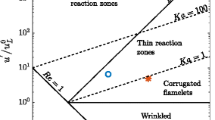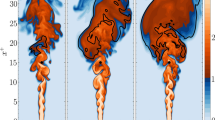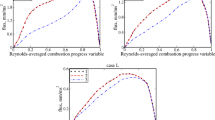Abstract
Recently, a simple model for evaluating turbulent scalar flux in premixed flames was developed and validated using six experimental data sets obtained from flames stabilized in impinging jets (Sabelnikov and Lipatnikov, Combust. Sci. Technol. 183, 588–613, 2011; Sabelnikov and Lipatnikov, Flow Turbulence Combust. 90, 387–400, 2013). The model addresses the flamelet regime of premixed turbulent combustion and yields an algebraic expression for the mean velocity conditioned to unburned mixture, while turbulent scalar flux is evaluated substituting this conditioned velocity into the well-known Bray-Moss-Libby (BML) expressions. The present work aims at further assessment of the aforementioned model against two well-known 3D DNS databases obtained from statistically planar, 1D premixed turbulent flames characterized by various density ratios (7.53, 5.0, 3.3, and 2.5). For the highest density ratio, an excellent agreement between the model and DNS data was obtained. This result is particularly encouraging, because the experimental data used earlier to test the model are associated with approximately the same (7-8) density ratios. However, the DNS data obtained for lower density ratios indicate a trend, not addressed by the original model, i.e. a model parameter is not a constant but decreases with decreasing density ratio, with the dependence of the model parameter on the density ratio being roughly linear for three flames addressed by one DNS database. Implementation of this linear fit into the model makes it consistent both with the DNS and with all experimental data used earlier to validate the original model.
Similar content being viewed by others
References
Clavin, P., Williams, F.A.: Theory of premixed-flame propagation in large-scale turbulence. J. Fluid Mech. 90, 589–604 (1979)
Libby, P.A., Bray, K.N.C.: Countergradient diffusion in premixed turbulent flames. AIAA J. 19, 205–213 (1981)
Moss, J.B.: Simultaneous measurements of concentration and velocity in an open premixed turbulent flame. Combust. Sci. Technol. 22, 119–129 (1980)
Yanagi, T., Mimura, Y.: Velocity-temperature correlation in premixed flame. Proc. Combust. Inst. 18, 1031–1039 (1981)
Bray, K.N.C.: Turbulent transport in flames. Proc. R. Soc. London A 451, 231–256 (1995)
Lipatnikov, A.N., Chomiak, J.: Effects of premixed flames on turbulence and turbulent scalar transport. Prog. Energy Combust. Sci. 36, 1–102 (2010)
Lipatnikov, A.N.: Fundamentals of Premixed Turbulent Combustion. CRC Press (2012)
Robin, V., Mura, A., Champion, M.: Algebraic models for turbulent transports in premixed flames. Combust. Sci. Technol. 184, 1718–1742 (2012)
Bray, K.N.C, Moss, J.B.: A unified statistical model for the premixed turbulent flame. Acta Astronautica 4, 291–319 (1977)
Libby, P.A., Bray, K.N.C.: Variable density effects in premixed turbulent flames. AIAA J. 15, 1186–1193 (1977)
Sabelnikov, V.A., Lipatnikov, A.N.: A simple model for evaluating conditioned velocities in premixed turbulent flames. Combust. Sci. Technol. 183, 588–613 (2011)
Sabelnikov, V.A., Lipatnikov, A.N.: Towards an extension of TFC model of premixed turbulent combustion. Flow Turbulence Combust. 90, 387–400 (2013)
Chen, J.H., Lumley, J.L., Gouldin, F.C.: Modeling of wrinkled laminar flames with intermittency and conditional statistics. Proc. Combust. Inst. 21, 1483–1491 (1986)
Im, Y.H., Huh, K.Y., Nishiki, S., Hasegawa, T.: Zone conditional assessment of flame-generated turbulence with DNS database of a turbulent premixed flame. Combust. Flame 137, 478–488 (2004)
Lipatnikov, A.N.: Conditionally averaged balance equations for modeling premixed turbulent combustion in flamelet regime. Combust. Flame 152, 529–547 (2008)
Cho, P., Law, C.K., Cheng, R.K., Shepherd, I.G.: Velocity and scalar fields of turbulent premixed flames in stagnation flow. Proc. Combust. Inst. 22, 739–745 (1988)
Cheng, R.K., Shepherd, I.G.: The influence of burner geometry on premixed turbulent flame propagation. Combust. Flame 85, 7–26 (1991)
Li, S.C., Libby, P.A., Williams, F.A.: Experimental investigation of a premixed flame in an impinging turbulent stream. Proc. Combust. Inst. 25, 1207–1214 (1994)
Stevens, E.J., Bray, K.N.C., Lecordier, B.: Velocity and scalar statistics for premixed turbulent stagnation flames using PIV. Proc. Combust. Inst. 27, 949–955 (1998)
Rutland, C.J., Cant, R.S.: Turbulent transport in premixed flames.. In: Proceedings of 1994 Summer Program, Centre for Turbulence Research, pp 75–94. Stanford University/NASA Ames, Stanford (1994)
Nishiki, S.: DNS and Modeling of Turbulent Premixed Combustion, Ph.D. thesis, Nagoya Institute of Technology (2003)
Nishiki, S., Hasegawa, T., Borghi, R., Himeno, R.: Modeling of flame-generated turbulence based on direct numerical simulation databases. Proc. Combust. Inst. 29, 2017–2022 (2002)
Nishiki, S., Hasegawa, T., Borghi, R., Himeno, R.: Modelling of turbulent scalar flux in turbulent premixed flames based on DNS databases. Combust. Theory Modell. 10, 39–55 (2006)
Chakraborty, N., Lipatnikov, A.N.: Conditional velocity statistics for high and low Damköhler number turbulent premixed combustion in the context of Reynolds averaged Navier Stokes simulations. Proc. Combust. Inst. 34, 133–1345 (2013)
Chakraborty, N., Lipatnikov, A.N.: Effects of Lewis number on conditional fluid velocity statistics in low Damköhler number turbulent premixed combustion: A direct numerical simulation analysis. Phys. Fluids 25, 045101 (2013)
Veynante, D., Trouvé, A., Bray, K.N.C., Mantel, T.: Gradient and counter-gradient scalar transport in turbulent premixed flames. J. Fluid Mech. 332, 263–293 (1997)
Swaminathan, N., Bilger, R.W., Ruetsch, G.R.: Interdependence of the instantaneous flame front structure and the overall scalar flux in turbulent premixed flames. Combust. Sci. Technol. 128, 73–97 (1997)
Tullis, S., Cant, R.S.: Scalar transport modeling in large eddy simulation of turbulent premixed flames. Proc. Combust. Inst. 29, 2097–2105 (2002)
Swaminathan, N., Grout, R.W.: Interaction of turbulence and scalar fields in premixed flames. Phys. Fluids 18, 045102 (2006)
Chakraborty, N., Swaminathan, N.: Influence of the Damköhler number on turbulence-scalar interaction in premixed flames. I. Physical insight. Phys. Fluids, 045103 (2007)
Chakraborty, N., Swaminathan, N.: Influence of the Damköhler number on turbulence-scalar interaction in premixed flames. II. Model development. Phys. Fluids 19, 045104 (2007)
Chakraborty, N., Rogerson, J.W., Swaminathan, N.: A priori assessment of closures for scalar dissipation rate transport in turbulent premixed flames using direct numerical simulation. Phys. Fluids 20, 045106 (2008)
Chakraborty, N., Katragadda, M., Cant, R.S.: Statistics and modelling of turbulent kinetic energy transport in different regimes of premixed combustion. Flow Turbulence Combust. 87, 205–235 (2011)
Bray, K.N.C., Champion, M., Libby, P.A., Swaminathan, N.: Scalar dissipation and mean reaction rates in premixed turbulent combustion. Combust. Flame 158, 2017–2022 (2011)
Chakraborty, N., Lipatnikov, A.N.: Statistics of conditional fluid velocity in the corrugated flamelets regime of turbulent premixed combustion: A Direct Numerical Simulation study. J. Combust. 2011, 628208 (2011)
Mura, A., Robin, V., Hasegawa, T.: Modelling of the correlation between velocity and reactive scalar gradients in turbulent premixed flames based on DNS data. Combust. Theory Modell. 12, 671–698 (2008)
Mura, A., Robin, V., Champion, M., Hasegawa, T.: Small scale features of velocity and scalar fields in turbulent premixed flames. Flow Turbulence Combust. 82, 339–358 (2009)
Robin, V., Mura, A., Champion, M., Hasegawa, T.: Direct and indirect thermal expansion effects in turbulent premixed flames. Combust. Sci. Technol. 182, 449–464 (2010)
Robin, V., Mura, A., Champion, M.: Modeling of the effects of thermal expansion on scalar turbulent fluxes in turbulent premixed flames. J. Fluid Mech. 689, 149–182 (2011)
Lipatnikov, A.N., Chomiak, J., Sabelnikov, V.A., Nishiki, S., Hasegawa, T.: Unburned mixture fingers in premixed turbulent flames. Proc. Combust. Inst. 35. in press, available at doi:10.1016/j.proci.2014.06.081
Lipatnikov, A.N., Sabelnikov, V.A., Nishiki, S., Hasegawa, T.: Assessment of a simple model for evaluating turbulent scalar flux in premixed flames against DNS data. In: 6-th European Combustion Meeting, Lund, Sweden, P4–62 (2013)
Pope, S.B.: The evolution of surface in turbulence. Int. J. Engng. Sci. 26, 445–469 (1988)
Trouvé, A., Poinsot, T.: Evolution equation for flame surface density in turbulent premixed combustion. J. Fluid Mech. 278, 1–31 (1994)
Veynante, D., Vervisch, L.: Turbulent combustion modeling. Prog. Energy Combust. Sci. 28, 193–266 (2002)
Bell, J.B., Day, M.S., Grcar, J.F., Lijewski, M.J.: Active control for statistically stationary turbulent premixed flame simulations. Comm. Appl. Math. Comput. Sci. 1, 29–51 (2006)
Poludnenko, A.Y., Oran, E.S.: The interaction of high-speed turbulence with flames: Global properties and internal flame structure. Combust. Flame 157, 995–1011 (2010)
Poludnenko, A.Y., Oran, E.S.: The interaction of high-speed turbulence with flames: Turbulent flame speed. Combust. Flame 158, 301–326 (2011)
Lipatnikov, A.N.: Transient behavior of turbulent scalar transport in premixed flames. Flow Turbulence Combust. 86, 609–637 (2011)
Lipatnikov, A.N., Sabelnikov, V.A.: Transition from countergradient to gradient scalar transport in developing premixed turbulent flames. Flow Turbulence Combust. 90, 401–418 (2013)
Swaminathan, N., Bilger, R.W., Cuenot, B.: Relationship between turbulent scalar flux and conditional dilatation in premixed flames with complex chemistry. Combust. Flame 126, 1764–1779 (2001)
Zhang, S., Rutland, C.J.: Premixed flame effects on turbulence and pressure related terms. Combust. Flame 102, 447–461 (1995)
Metghalchi, M., Keck, J.C.: Burning velocities of mixtures of air with methanol, iso-octane, and indolene at high pressure and temperature. Combust. Flame 48, 191–210 (1982)
Gülder, Ö.L.: Laminar burning velocities of methanol, ethanol, and isooctane-air mixtures. Proc. Combust. Inst 19, 275–281 (1982)
Müller, U.C., Bollig, M., Peters, N.: Approximations for burning velocities and Markstein numbers for lean hydrocarbon and methanol flames. Combust. Flame 108, 349–356 (1997)
Marshall, S.P., Taylor, S., Stone, C.R., Davies, T.J., Cracknell, R.F.: Laminar burning velocity measurements of liquid fuels at elevated pressures and temperature with combustion residuals. Combust. Flame 158, 1920–1932 (2011)
Galmiche, B., Halter, F., Foucher, F.: Effects of high pressure, high temperature and dilution on laminar burning velocities and Markstein lengths of iso-octane/air mixtures. Combust. Flame 159, 3286–3299 (2012)
Enaux, B., Granet, V., Vermorel, O., Lacour, C., Pera, C., Angelberger, C., Poinsot, T.: LES study of cycle-to-cycle variations in a spark ignition engine. Proc. Combust. Inst. 33, 3115–3122 (2011)
Baumann, M., di Mare, F., Janicka, J.: On the validation of LES applied to internal combustion engine flows: Part II: Numerical analysis. Flow Turbulence Combust. 92, 299–317 (2014)
Author information
Authors and Affiliations
Corresponding author
Rights and permissions
About this article
Cite this article
Lipatnikov, A.N., Sabelnikov, V.A., Nishiki, S. et al. DNS Assessment of a Simple Model for Evaluating Velocity Conditioned to Unburned Gas in Premixed Turbulent Flames. Flow Turbulence Combust 94, 513–526 (2015). https://doi.org/10.1007/s10494-014-9588-7
Received:
Accepted:
Published:
Issue Date:
DOI: https://doi.org/10.1007/s10494-014-9588-7




